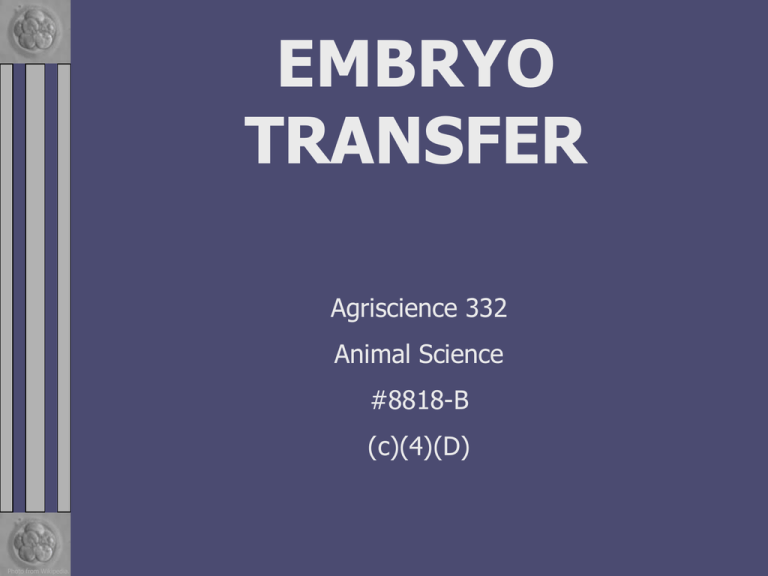
EMBRYO
TRANSFER
Agriscience 332
Animal Science
#8818-B
(c)(4)(D)
Photo from Wikipedia.
Introduction
Embryo transfer is a process
by which an embryo is
collected from a donor female
and transferred into a recipient
female where the embryo
completes its development.
Photo from Wikipedia.
Through the use of embryo
transfer, a genetically superior
female produces more offspring
than she could by natural
reproduction, thus maximizing
her genetic abilities.
Photo from Wikipedia.
Embryo transfer is profitable for
producers of registered
purebred animals and is used in
several species of domestic
animals, especially cattle,
horses, goats, and sheep.
It has also been used in nondomestic species, such as deer,
elk, bison, and wildcats.
Photo from Wikipedia.
The first embryo transfer was
performed in 1890 at the
University of Cambridge using
rabbits.
It was not until 1951 that the
technique was successfully used
in cattle and has since become
a more popular procedure for
other animal species.
Photo from Wikipedia.
As long as embryo transfer
remains a key step in many of
the developing technologies,
such as prenatal sex selection,
the commercial embryo transfer
industry will continue to grow.
Photo from Wikipedia.
Photo from Wikipedia.
Donor, Superovulation,
and Insemination
The producer should consider the
following factors when developing
an embryo transfer program:
• Selection of donor females,
• Superovulation, and
• Insemination.
Photo from Wikipedia.
Donor Female Selection
The donor female selected for
embryo transfer should have
outstanding genetics.
She should also be healthy and
reproductively sound.
Photo from Wikipedia.
Superovulation
Superovulation refers to the
release of many oocytes (eggs)
during a single estrus period.
Normally, only one follicle
ruptures in cows and mares
releasing one ovum and two
follicles rupture in ewes
releasing two ovum.
Photo from Wikipedia.
Superovulation can be achieved
through treatment with
gonadotropins.
Most embryo transfer donors
are treated with follicle
stimulating hormone (FSH) to
induce the maturation and
ovulation of a larger than
normal number of oocytes.
Photo from Wikipedia.
For example, a single treatment
of a cow results in 0 to 20 more
embryos, with an average of
seven normal embryos.
Photo from Wikipedia.
When attempts are made to
recover a single ovum from a
non-superovulated cow at every
estrus, the 12-month yield
averages 5 calves.
In contrast, when a donor is
superovulated three times, the
yield ranges from 9 to 12 calves.
Photo from Wikipedia.
Following embryo transfer,
superovulated ova result in
normal offspring with success
rates similar to those achieved
with normally ovulated ova.
Photo from Wikipedia.
Adequate procedures exist for
superovulation of laboratory
and livestock species, except
for horses.
A mare does not respond
satisfactorily to superovulatory
treatment, thus maximization
of reproduction in mares must
be achieved by collecting
embryos at each estrus.
Photo from Wikipedia.
Insemination
Because superovulation of the
donor female causes the
release of a large number of
eggs over a 24-hour period,
many producers choose to
inseminate the donor several
times to achieve optimal
fertilization.
Photo from Wikipedia.
Embryo Recovery
Success of embryo recovery
depends on the age of the
embryos, as well as, the
technical procedure used and
the skill level of the technician.
Photo from Wikipedia.
With superovulated donors,
many follicles never ovulate;
others may develop as if they
had ovulated, but they never
release oocytes.
Photo from Wikipedia.
Furthermore, if the ovaries
enlarge greatly in response to
superovulatory treatment or if
many ovulations occur, the
fimbriae apparently do not
gather all of the oocytes into
the oviducts.
Photo from Wikipedia.
Radically altered endocrine levels
may occur as a result of
superovulatory treatment.
This causes the uterus to become
an unfavorable environment for
embryonic development.
The incidence of degenerate
embryos may increase during
days 7 and 8 after estrus.
Photo from Wikipedia.
It is difficult to count the number
of ovulations in superovulated
donors, even with surgical
examination.
With non-surgical recovery
methods, the number of
ovulations can only be estimated
by palpation.
Photo from Wikipedia.
Non-Surgical Recovery
Advances in technology have
made embryo recovery a nonsurgical procedure with cattle
and horses.
A specially designed catheter
(Foley catheter) is used when
collecting embryos using nonsurgical methods.
Photo from Wikipedia.
Photo from Wikipedia.
Steps in non-surgical procedure
for embryo recovery:
1. Clean the donor’s genital area.
2. Inject a local anesthetic in the
rump or hip.
3. After anesthetic takes effect,
insert the Foley catheter into
the vagina and through the
cervix.
Photo from Wikipedia.
4. Flush out the embryos by
forcing fluid from the catheter
into the uterus and collecting
it in a special container, which
filters out the embryos.
Photo from Wikipedia.
Surgical Recovery
Unfertilized oocytes for
specialized applications, such
as in-vitro fertilization, must be
collected near the time of
ovulation from the follicles,
surface of the ovary, or oviduct.
Photo from Wikipedia.
For most applications, embryos
are collected anytime between
fertilization and implantation,
but usually after they migrate
to the uterus.
Photo from Wikipedia.
In cattle and horses, embryos
for commercial purposes are
usually recovered 6 to 9 days
after estrus.
Before this time, non-surgical
recovery is ineffective.
Photo from Wikipedia.
After 9 days, recovery and
pregnancy rates are slightly
reduced, at least with surgical
transfer of bovine embryos.
Surgical recovery can be done
in all species and is the method
of choice for sheep, goats, and
hogs.
Techniques vary slightly with
the species.
Photo from Wikipedia.
Embryo Evaluation
After collection, embryos are
evaluated for quality using a
stereoscopic microscope.
Embryos are graded on a scale
from one (excellent) to four
(poor).
Photo from Wikipedia.
Factors considered during the
evaluation include:
• Shape,
• Color,
• Texture, and
• Size.
Photo from Wikipedia.
Embryos are also classified based
on their stages of development.
Normal embryos will have
between 2 and 64 cells.
Photo from Wikipedia.
Embryo Storage
Donor embryos can be
transferred immediately into
recipients or they can be
stored for future use.
Photo from Wikipedia.
Procedures such as embryo
transfer, in-vitro fertilization,
sex determination, and cloning
depend on maintaining the
viability of embryos for hours
to days outside of the
reproductive tract.
Photo from Wikipedia.
For many applications, the
storage system must not only
maintain the viability of the
embryo, it must also support
continued development.
Photo from Wikipedia.
In some cases, it may be desirable
to retard the growth of the
embryo to a degree approaching
suspended animation, so that
development can be synchronized
with later events.
For example, it may be necessary
to store embryos until suitable
recipients become available for
transfer.
Photo from Wikipedia.
Short-Term Storage
Embryos can be stored at room
temperature for one day for
direct transfer from the donor
to the recipients.
Photo from Wikipedia.
Embryos must be stored at 5°C
in an appropriate medium, if kept
24 to 48 hours.
Most media and culture systems
are adequate for maintaining the
viability of the embryo between
donor and recipient.
Photo from Wikipedia.
Long-Term Storage
If embryos are to be transported
great distances or suitable
recipients are not immediately
available, a long-term storage
system is essential.
Deep-freezing means that
embryos are stored in liquid
nitrogen for a long period of time.
Photo from Wikipedia.
Long-term storage through
freezing usually results in
damage of 30% to 50% of the
stored embryos.
Damage is usually caused by ice
crystal formation within the
embryonic cell.
Photo from Wikipedia.
Although the average survival
rate of frozen-thawed embryos
is approximately 65%, it is
profitable to maintain embryos
in long-term storage.
Photo from Wikipedia.
Transfer of Embryos
into Recipient Cows
Recipients to be implanted with
the collected embryos should be
healthy and reproductively
sound.
Photo from Wikipedia.
To maximize success rate of the
transfer, the recipient’s estrus
should be in sync with that of the
donor.
Estrus synchronization is important
to establish a uniform uterine
environment for the embryo;
therefore, only one day or less
difference in estrus between donor
and recipient is acceptable.
Photo from Wikipedia.
Research indicates that there is
little difference in pregnancy
rates between natural estrus and
induced estrus recipients.
Induced estrus for
synchronization is accomplished
with treatments of progestogens,
which are synthetic progesterone
products.
Photo from Wikipedia.
Non-Surgical Transfer of Embryos
For cattle and horses,
technicians mainly use nonsurgical techniques to recover
and transplant embryos.
Photo from Wikipedia.
Flushed embryos that pass
inspection are loaded into an
AI straw.
An insemination rod is passed
through the recipient’s cervix
and into her uterus (similar to
AI procedure).
Photo from Wikipedia.
The embryo is expelled into the
uterine horn that is on the same
side as the ovulated ovary (to
optimize the embryo
implantation rate).
Photo from Wikipedia.
Surgical Transfer of Embryos
Embryos in early stages of
development must be deposited
in the oviducts.
This procedure must be
performed surgically.
Surgery is also required for
uterine transfers in sheep, goats,
and hogs.
Photo from Wikipedia.
Success of surgical transfer
depends on interactions of a
number of factors, including:
• Age and quality of embryos,
• Site of transfer,
• Degree of estrus synchronization
between donor and recipients,
Photo from Wikipedia.
• Number of embryos transferred,
• In-vitro culture conditions,
• Skill of personnel, and
• Management techniques.
Photo from Wikipedia.
Conception rates are up to 5%
greater with surgical transfer.
Surgical transfer of normal
embryos compares to the firstservice pregnancy rates using
artificial insemination.
Photo from Wikipedia.
The reproductive tract can be
exposed for surgical transfer of
embryos.
Transfer occurs through a midline
laparotomy (incision through the
abdominal wall) with general
anesthesia or through a flank
incision with local anesthesia.
Photo from Wikipedia.
The midline approach is less
traumatic to the reproductive
tract and permits better
exposure in some animals.
The flank approach, on the
other hand, is quicker, less
expensive, and reduces risk by
using minimum equipment.
Photo from Wikipedia.
Embryo Survival
The survival rate of the embryo,
from implantation to term in the
recipient female, ranges from
55% to 70%.
Embryo quality is an important
determinant of transfer success.
Photo from Wikipedia.
The most accurate predictor of
success is the stage of
embryonic development.
Recipient females are palpated
within one to three months
after embryo transfer to
diagnose stage of pregnancy.
Photo from Wikipedia.
New Technologies
Embryo transfer is a composite
technology that requires
expertise in many areas.
Photo from Wikipedia.
Present and emerging technologies
that build upon current embryo
transfer procedures include
predetermination of sex, sex
selection, in-vitro culture,
production of identical twins, and
cloning.
Photo from Wikipedia.
In addition, embryo transfer
techniques proliferate a number
of new industries, such as
research and growth in
gonadotropin purification,
manufacturing of
micromanipulators and other
specialized equipment,
international marketing of
embryos, and specialized
investment counseling.
Photo from Wikipedia.
Summary
Embryo transfer is a technology
that can be used to maximize
the production from superior
females.
Embryo transfer requires skill in
the management of reproductive
cycles and skill in the
performance of the procedure.
Photo from Wikipedia.
ALL RIGHTS RESERVED
Reproduction or redistribution of all, or
part, of this presentation without
written permission is prohibited.
Instructional Materials Service
Texas A&M University
2588 TAMUS
College Station, Texas 77843-2588
http://www-ims.tamu.edu
2007
Photo from Wikipedia.







